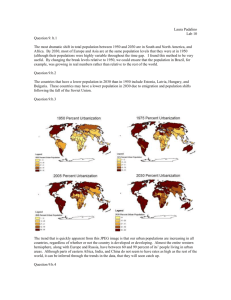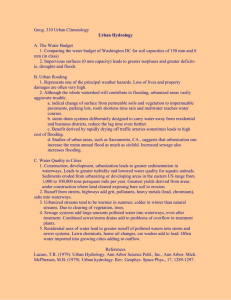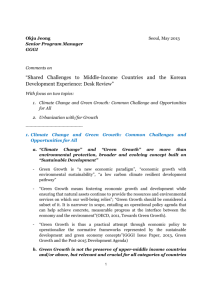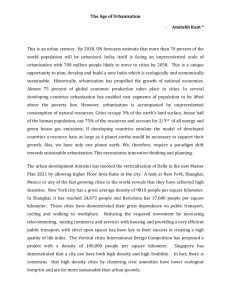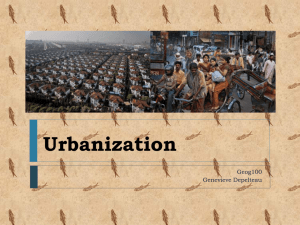258 KB
advertisement
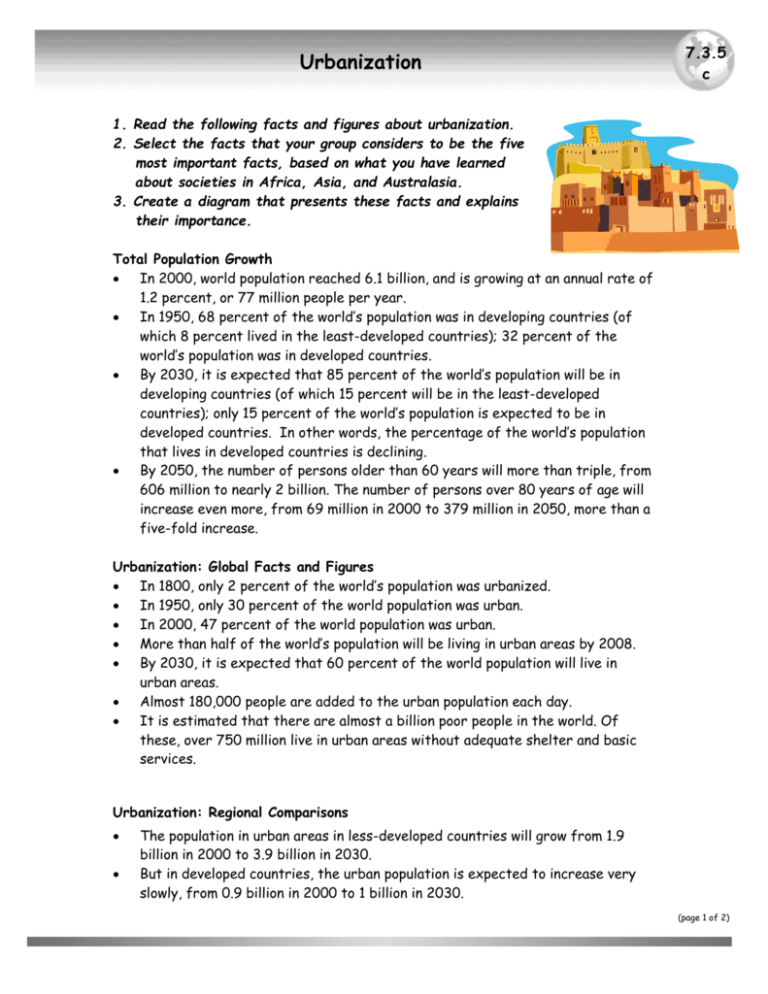
Urbanization 7.3.5 c 1. Read the following facts and figures about urbanization. 2. Select the facts that your group considers to be the five most important facts, based on what you have learned about societies in Africa, Asia, and Australasia. 3. Create a diagram that presents these facts and explains their importance. Total Population Growth In 2000, world population reached 6.1 billion, and is growing at an annual rate of 1.2 percent, or 77 million people per year. In 1950, 68 percent of the world’s population was in developing countries (of which 8 percent lived in the least-developed countries); 32 percent of the world’s population was in developed countries. By 2030, it is expected that 85 percent of the world’s population will be in developing countries (of which 15 percent will be in the least-developed countries); only 15 percent of the world’s population is expected to be in developed countries. In other words, the percentage of the world’s population that lives in developed countries is declining. By 2050, the number of persons older than 60 years will more than triple, from 606 million to nearly 2 billion. The number of persons over 80 years of age will increase even more, from 69 million in 2000 to 379 million in 2050, more than a five-fold increase. Urbanization: Global Facts and Figures In 1800, only 2 percent of the world’s population was urbanized. In 1950, only 30 percent of the world population was urban. In 2000, 47 percent of the world population was urban. More than half of the world’s population will be living in urban areas by 2008. By 2030, it is expected that 60 percent of the world population will live in urban areas. Almost 180,000 people are added to the urban population each day. It is estimated that there are almost a billion poor people in the world. Of these, over 750 million live in urban areas without adequate shelter and basic services. Urbanization: Regional Comparisons The population in urban areas in less-developed countries will grow from 1.9 billion in 2000 to 3.9 billion in 2030. But in developed countries, the urban population is expected to increase very slowly, from 0.9 billion in 2000 to 1 billion in 2030. (page 1 of 2) Urbanization 7.3.5 c The overall growth rate for the world for that period is 1 percent, while the growth rate for urban areas is nearly double, or 1.8 percent. At that rate, the world’s urban population will double in 38 years. Growth will be even more rapid in the urban areas of less-developed regions, averaging 2.3 percent per year, with a doubling time of 30 years. The urbanization process in more-developed countries has stabilized with about 75 percent of the population living in urban areas. By 2030, 84 percent of the population in more-developed countries will be living in urban areas. Latin America and the Caribbean were 50 percent urbanized by 1960 but are now in the region of 75 percent. Though Africa is predominantly rural, with only 37.3 percent living in urban areas in 1999, with a growth rate of 4.87 percent, Africa is the continent with the fastest rate of urbanization. In 1999, 36.2 percent of the Asian population was urbanized and the urban growth rate is in the region of 3.77 percent. The urban population of developing countries is expected to reach 50 percent in 2020. By 2030, Asia and Africa will both have higher numbers of urban dwellers than any other major area of the world. Urban Agglomerations, or More Mega Cities In 1950, there was only one city with a population of over 10 million inhabitants: New York City. By 2015, it is expected that there will be 23 cities with a population over 10 million. Of the 23 cities expected to reach 10 million-plus by 2015, 19 of them will be in developing countries. In 2000 there were 22 cities with a population of between 5 and 10 million; there were 402 cities with a population of 1 to 5 million; and 433 cities in the .5 to 1 million category. Source: Urbanization Facts and Figures <www.unhabitat.org/Istanbul+5/booklet4.pdf> (page 2 of 2)
